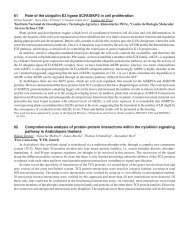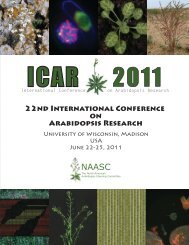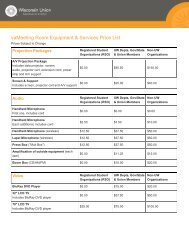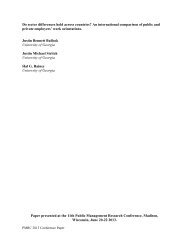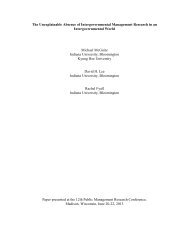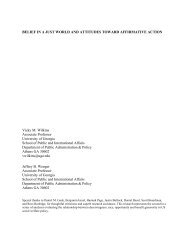PROGRAM & ABSTRACTS - Wisconsin Union - University of ...
PROGRAM & ABSTRACTS - Wisconsin Union - University of ...
PROGRAM & ABSTRACTS - Wisconsin Union - University of ...
You also want an ePaper? Increase the reach of your titles
YUMPU automatically turns print PDFs into web optimized ePapers that Google loves.
Aging, Metabolism, Stress, Pathogenesis, and Small RNAs in C. elegans Topic Meeting 2012<br />
HLH-30 is a new Transcription Factor involved in C. elegans Host<br />
Response triggered by S. aureus Infection<br />
Orane Visvikis 1 , Nnamdi Ihuegbu 2 , Lyly Luhachack 1 , Amanda Wollenberg 1 , Anna-Maria<br />
Alves 1 , Gary Stormo 2 , Javier Irazoqui 1<br />
1 Program <strong>of</strong> Developmental Immunology, Massachusetts General Hospital,<br />
Boston (MA), USA, 2 Center for Genome Sciences, Washington <strong>University</strong>, St.<br />
Louis (MO), USA<br />
The human pathogen Staphylococcus aureus can infect and kill Caenorhabditis elegans.<br />
Previous microarray analysis showed that S. aureus triggers a pathogen-specific transcriptional<br />
host response, which appears to be regulated by Toll-like receptor-independent sensing <strong>of</strong><br />
pathogen-associated molecular patterns (PAMPs). To identify components that orchestrate the<br />
C. elegans host response, we performed bioinformatic analysis and identified evolutionarily<br />
conserved DNA motifs that are over-represented in the promoters <strong>of</strong> S. aureus induced<br />
genes (SAIGs). One such motif corresponds to the HLH-30 binding E-box. hlh-30 expression<br />
analysis by RT-qPCR revealed a 2-fold up-regulation upon infection. Additionally, we generated<br />
transgenic animals over-expressing HLH-30::GFP under its own promoter. HLH-30::GFP protein<br />
was found to accumulate in the nucleus upon infection, consistent with the hypothesis that<br />
HLH-30 is a transcription factor involved in the host response to S. aureus infection.<br />
To test this hypothesis, we performed RNA-seq to determine the downstream target genes<br />
<strong>of</strong> HLH-30 in uninfected and infected animals. Of 825 SAIGs identified in wild-type animals,<br />
637 SAITs (77%) were not induced in hlh-30(-) animals, confirming that HLH-30 plays a<br />
key role in the C. elegans host response to S. aureus. GO annotation <strong>of</strong> these 637 HLH-30<br />
dependent SAIGs revealed enriched terms related to antimicrobial factors. We used RT-qPCR<br />
and in vivo reporter analysis to confirm that HLH-30 controls induction <strong>of</strong> antimicrobial factors<br />
during infection. Consistently, we found that hlh-30(-) mutants exhibit enhanced susceptibility<br />
to S.aureus-mediated killing. Therefore, we suspect that the transcriptional defect observed<br />
in hlh-30(-) animals is biologically significant for host defense. Interestingly, we found that hlh-<br />
30(-) animals also display enhanced susceptibility to other C. elegans pathogens (S.enterica,<br />
P. aeruginosa, E. faecalis) suggesting that HLH-30 might also regulate the host response to<br />
these three pathogens. We also found that HLH-30 regulates expression <strong>of</strong> stress and aging<br />
genes. Consistently, we found that hlh-30(-) mutants are short-lived on non pathogenic food,<br />
and exhibit enhanced susceptibility to heat-shock and starvation, but not to oxidative stress.<br />
Altogether, these data indicate that HLH-30 is a major transcription factor that can control<br />
a biologically significant transcriptional host response to stresses such as S. aureus infection.<br />
Contact: ovisvikis@partners.org<br />
Lab: Irazoqui<br />
14<br />
Session 2



